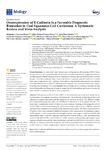Overexpression of E-Cadherin Is a Favorable Prognostic Biomarker in Oral Squamous Cell Carcinoma: A Systematic Review and Meta-Analysis

Use este enlace para citar
http://hdl.handle.net/2183/32920Colecciones
- Investigación (FEP) [507]
Metadatos
Mostrar el registro completo del ítemTítulo
Overexpression of E-Cadherin Is a Favorable Prognostic Biomarker in Oral Squamous Cell Carcinoma: A Systematic Review and Meta-AnalysisAutor(es)
Fecha
2023-02Cita bibliográfica
Lorenzo-Pouso, A.I.; Silva, F.F.-V.e.; Pérez-Jardón, A.; Chamorro-Petronacci, C.M.; Oliveira-Alves, M.G.; Álvarez-Calderón-Iglesias, Ó.; Caponio, V.C.A.; Pinti, M.; Perrotti, V.; Pérez-Sayáns, M. Overexpression of E-Cadherin Is a Favorable Prognostic Biomarker in Oral Squamous Cell Carcinoma: A Systematic Review and Meta-Analysis. Biology 2023, 12, 239. https://doi.org/10.3390/biology12020239
Resumen
[Abstract] Oral squamous cell carcinoma (OSCC) is characterized by poor survival, mostly due to local invasion, loco-regional recurrence, and metastasis. Given that the weakening of cell-to-cell adhesion is a feature associated with the migration and invasion of cancer cells, different studies have explored the prognostic utility of cell adhesion molecules such as E-cadherin (E-cad). This study aims to summarize current evidence in a meta-analysis, focusing on the prognostic role of E-cad in OSCC. To find studies meeting inclusion criteria, Scopus, Web of Science, EMBASE, Medline, and OpenGrey databases were systematically assessed and screened. The selection process led to 25 studies, which were considered eligible for inclusion in the meta-analysis, representing a sample of 2553 patients. E-cad overexpression was strongly associated with longer overall survival (OS) with Hazard Ratio (HR) = 0.41 95% confidence interval (95% CI) (0.32–0.54); p < 0.001 and disease-free survival with HR 0.47 95% CI (0.37–0.61); p < 0.001. In terms of OS, patients with tongue cancer experienced better survivability when expressing E-cad with HR 0.28 95% CI (0.19–0.43); p < 0.001. Globally, our findings indicate the prognostic role of the immunohistochemical assessment of E-cad in OSCC and its expression might acquire a different role based on the oral cavity subsites.
Palabras clave
E-cadherin
Epithelial-mesenchymal transition
Mouth neoplasm
Prognostic
Systematic review
Meta-analysis
Revisión sistemática
Pronóstico
E-cadherina
Transición epitelial mesenquimatosa
Neoplasia de boca
Metaanálisis
Epithelial-mesenchymal transition
Mouth neoplasm
Prognostic
Systematic review
Meta-analysis
Revisión sistemática
Pronóstico
E-cadherina
Transición epitelial mesenquimatosa
Neoplasia de boca
Metaanálisis
Versión del editor
Derechos
Atribución 3.0 España






